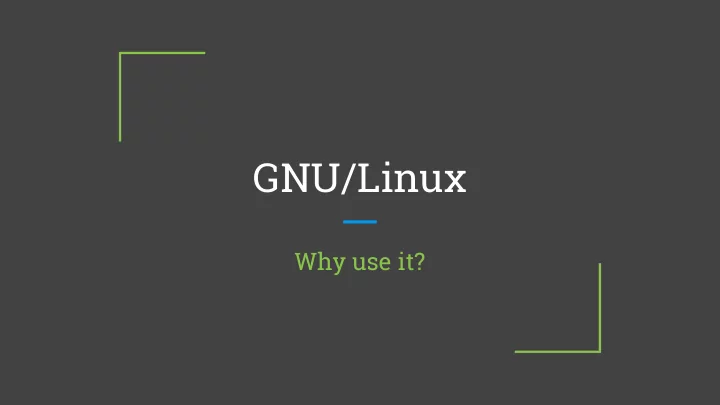

GNU/Linux Why use it?
What is Linux? Linux is a UNIX-like, GPL-licensed open-source kernel. The GNU userland consists of ● libc, ● the init system (SystemD) ● X11 ● GUI toolkits ● etc.
Ask the audience ● Who has used Linux? ● Who has a Linux install? ● Who only uses Linux? ● Which distros? Debian-based? Fedora/Redhat-based? ArchLinux? Gentoo? others?
Top 30 FOSS software Mozilla Firefox GRUB bootloader Apache web server ● ● ● ● Google Chromium ● MPlayer ● MySQL/MariaDB Linux kernel VLC PHP ● ● ● ● BSD kernels ● GParted ● JQuery gcc/g++ compiler CUPS print server webkit ● ● ● ● GIMP ● GNOME Desktop ● QEMU Inkscape KDE Desktop openJDK ● ● ● ● Blender ● GNU coreutils ● Eclipse LibreOffice vi/vim text editor Python ● ● ● ● LaTeX ● git version control ● Perl
Anatomy of a GNU/Linux system A proper distribution (Live-only distros not included) include a package manager, one or more package repositories, tailored configuration files, documentation, and optionally one or more pre-configured Desktop Environments. Major base distros : ArchLinux, Debian, Fedora, Gentoo, openSUSE, ● Slackware ● Core package managers : apt-get (Debian-based), emerge (Gentoo-based), pacman (Arch-based), yum (Fedora/Redhat-based), zypper (SUSE-based)
Anatomy of a GNU/Linux system (cont.) The Linux package paradigm is unlike those you may be familiar with: downloading software from random websites (Windows) or from "App Stores" (Mobile). All the components of the OS are individually packaged and dependent on other packages. Binary packages are uploaded to a central location and mirrored to participating trusted servers. Source packages are compiled and packaged locally from a provided text file "recipe" and downloaded source code. Key points to look for while distro hopping: ● Maintenance : package quality vs quantity, stable=old and bleeding-edge=experimental, can the package manager adapt to complex situations?, ease of building your own packages, etc. ● Upgrade path : rolling-release (incremental), upgrade-by-release, re-install required, or discontinued Documentation : chat, forums, release notes, start guide, wiki, etc. ●
Anatomy of a GNU/Linux system (cont.) Dependent on the vastness and variety of packages available in your distro's repos, you can change out individual components or switch to an entirely different desktop environment. These DEs often bundle a Window Manager, Login/Display Manager, a dock/panel as well as programs built with a specific GUI toolkit. ● Popular Desktop Environments : Cinnamon, Enlightenment/E17, Gnome, KDE, LXDE, MATE, Unity, XFCE ● Common Window Managers : Awesome, Compiz with or without Emerald, Fluxbox, FLWM, i3, JWM, Marco (MATE), Metacity (GNOME2), Muffin (Cinnamon), Mutter (GNOME3), OpenBox, Plasma (KDE) Major GUI toolkits : GTK, QT, TK. Also Java's AWT/SWING/SWT and Mono. ● ● Popular Display Managers : GDM (Gnome), KDM (KDE), LightDM, SLiM
Anatomy of a GNU/Linux system (cont.) You can theme entire DEs or individual components: WMs, GUI toolkits, icon sets, mouse cursor, display manager, widgets (conky), etc. Lastly you might hear rumblings about Display Servers : X.org's X11 (referred to as "X"), Wayland, and Canonical's Mir.
Distrohopping Linux Distro Timeline: http://tinyurl.com/linux-timeline2012 Live CD-Rs / DVD±Rs ● ● Live USB I-ODD virtual CD/USB emulator ●
Distro Wars Debian Fedora ArchLinux + Long term “stable” + Bleeding edge + Bleeding edge + Many packages + Many DEs supported + Okay packages + Many architectures + yum package manager + AUR repo + .deb format - .rpm format + PKGBUILDs - apt-get package - lack of packages - pacman package manager - depends on RPMFusion manager - lack of non-free for proprietary drivers - breakages - no install wizard
Distro Wars (cont.) openSUSE Ubuntu Gentoo + Long term “stable” + Long term “stable” + Highly configurable + Good installer + “Just works” + Portage/emerge - .rpm format + Many tutorials available package manager - zypper package + PPAs + Overlays manager - apt-get package + .ebuilds - lack of packages manager - compile everything - bad quality repos - USE flags - no install wizard
Demo: ACII fun and games asciiquarium ● cmatrix ● ● sl mplayer -vo caca/fbdev2 ● toilet ●
Demo: ncurses dialog ● greed ● ● nano tmux ● wavemon ●
Demo: window managers ● Compiz Fusion ● i3 WM
Demo: Photoframe
Demo: “volunteers” from audience CLI editor ctrl-x + e ● ● screen ● middle click paste ● sshfs
Demo: “volunteers” from audience (cont.) mkdir -p; tab completion ; alt + .; curly brace {} expansion ● ● sshfs and symlinks ● chroot and systemd-nspawn :() { :|:& };: and Magic SysRq ●
Demo: Terminals ● mate-terminal / gnome-terminal ● terminator ● tilda ● cool-retro-term ● VTs
Q&A
More Questions? GPU drivers ● Games (Steam, FOSS, etc.) ●
Links LUG and .ova images: http://linuxcsuf.pw Contact me http://hirekevin.xyz
Recommend
More recommend